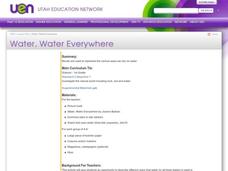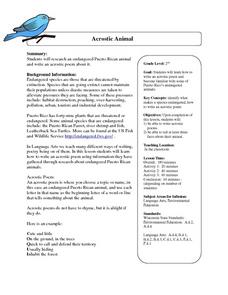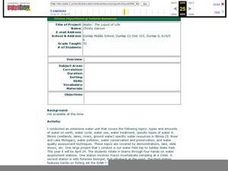Curated OER
Great Barrier Reef-Guarding Nemo
Students explore the Great Barrier Reef. In this environmental stewardship lesson, students conduct research regarding the Great Barrier Reef and examine methods to preserve the Reef. Students apply the RAFT method to prepare a final...
Curated OER
Ocean Currents
In this currents learning exercise, students review the Coriolis effect, surface currents, and density currents. This learning exercise has 8 short answer questions.
Curated OER
Pond Water Survey
For this survey worksheet students complete a series of short answers to questions on data collection, volume and populations of organisms.
Curated OER
Introduction to Dissolved Oxygen and Demonstration of a Simple Test Procedure
Young scholars explain the importance of dissolved oxygen in water ecosystems. They describe the aquatic oxygen cycle and the effect of water pollution on oxygen. They make observations, collect data and draw a conclusion.
Utah LessonPlans
Water, Water Everywhere
Murals are used to represent the various ways we rely on water.
Curated OER
Water, Water Everywhere
First graders study water-its properties, its 3 states, and the way we rely on it for everyday living. They read Water, Water Everywhere, draw murals of where they have seen water and the ways they use it and eat/drink snacks that are...
Curated OER
Acrostic Animal
Second graders listen as the teacher describes how an acrostic poem is written. They research an endangered animal of Puerto Rico. Students write an acrostic poem as a class, and then individually about the animal they research. Students...
Curated OER
Got Water?
Students determine that delivering clean, fresh water to citizens around the world involves and affects politics, economics, international relations, and technology. They brainstorm a list of factors that might affect their town's...
Curated OER
Can You Beat Jet Lag?
Learners examine the health condition of jet lag. Using mealworms, they test the effect of light on the development of them into adults. They answer discussion questions and examine the relationship of age and one's activity level.
Curated OER
N, B, and T: Pollutants Three
Students explore nutrient, bacterial, and toxic surface water pollution. They identify the amount of water they use each day and summarize the kinds of substances that cause water pollution. They predict what will happen in water...
Curated OER
Thermal Pollution
In this pollution instructional activity, students read about thermal pollution and how hot water affects wildlife. Then students complete 1 short answer question.
Curated OER
San Ignacio Lagoon: Economy or Ecology
Young scholars debate over the development in the habitat of gray whales. In this role playing lesson, students will take on various roles in a debate over the development of a salt production facility in the San Ignacio Lagoon...
Curated OER
Salmon Smolt: Stella PC and Mac
Students investigate the Stella Smolts Migration Model and its use in previous simulation models to help managers deal with the many factors contributing smolts decline. They participate in an interactive exercise in the role of fishery...
Curated OER
The Future of the Arctic National Wildlife Refuge
Students research the governments role is preserving the Arctic National Wildlife Refuge. They discuss the proponents and the opponents side of the issue.
Curated OER
The Intertidal Zone: Tides and How Creatures Survive
For this intertidal zone worksheet, students study the various marine life creatures and list the characteristic that allows them to stay put in the intertidal zone. Students then draw or cut and paste the marine life and seaweed into...
Curated OER
Skagway School Hatchery Involvement
Tenth graders are given the opportunity to use what they are learning in their other academic courses, as well as in the hatchery class.
Curated OER
Barnacles: Harder than Cement
Fourth graders watch the movements of the complex animal hidden inside the tiny barnacle shells. This lesson allows students to study the behavior, adaptation, and larval stage of the barnacle.
Curated OER
Water: The Liquid of Life
Sixth graders complete a lesson on the properties, types and amounts of water on Earth. In groups, they travel between stations to identify water resources in Illinois and pollution sources. They complete the lesson with a field trip...
Curated OER
Bats
Young scholars examine the migration patterns of the long-nosed bat. They identify threats to the animal and the plants bats help pollinate. They participate in a game to help them with the information.
Curated OER
Start a Herbarium
Students explore importance of a herbarium and start one of their own.
Curated OER
Going for the Green
Students use satellite imagery to obtain information on chlorophyll concentration at selected locations in the Earth's oceans.Students explain the relationship between chlorophyll concentration and primary production.Studen
Curated OER
Ring Detectives
Students describe the overall flow of the Gulf Stream, and explain how it affects biological communities in the North Atlantic Ocean.Students describe Gulf Stream rings, and explain how they are formed.Students be abl
Curated OER
Let Your Ears Do the Walking
Students examine the effects of bycatching on water environments. They discover how echolocation works. They participate in a simulation of the process to use it while walking blindfolded.
Curated OER
Who's Your Neighbor?
Students recognize and identify some of the fauna groups found in deep-sea coral reef communities. They describe common feeding strategies used by benthic animals in deep-sea coral reef communities.Students be able

























